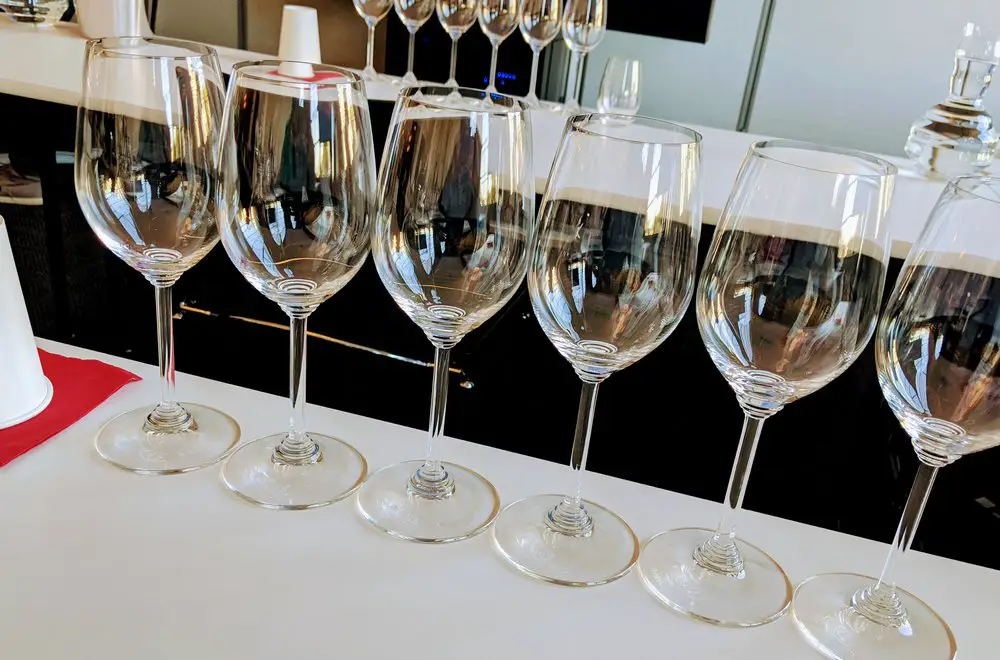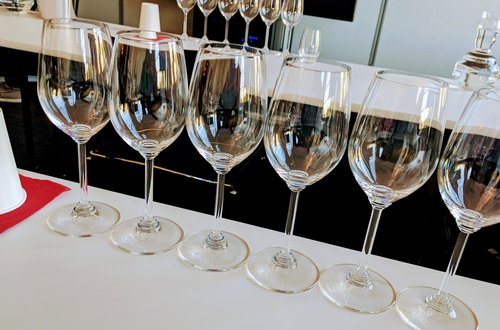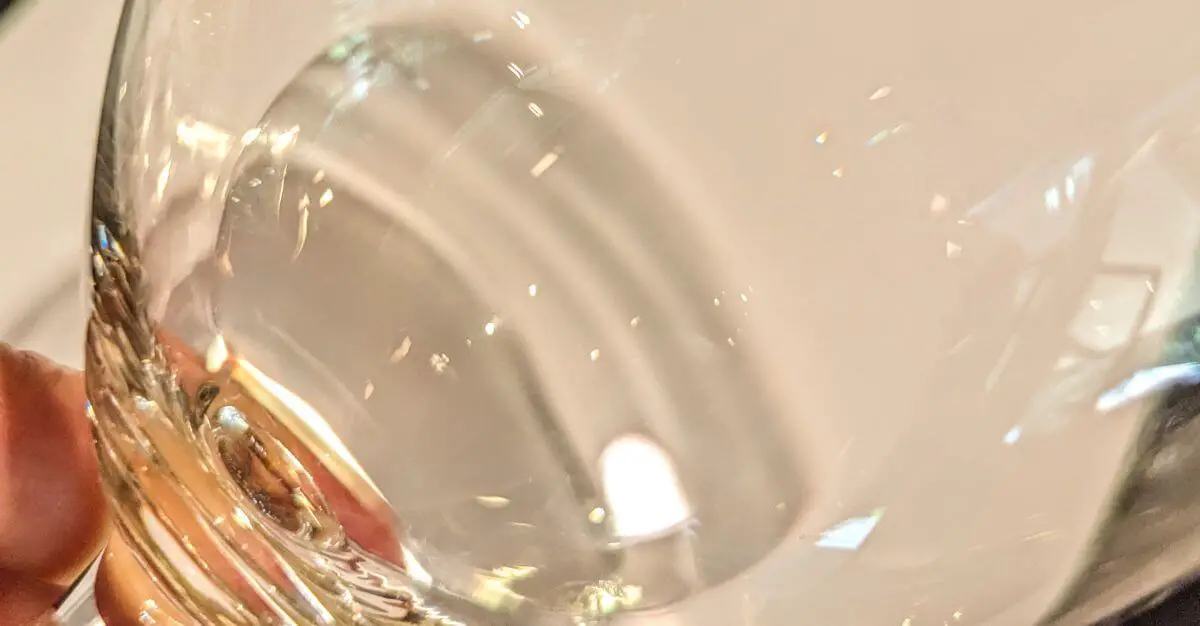
Getting ready for your next at-home wine tasting event and wondering about the wine tasting order? Here are some tried and true simple guidelines to get you started.
Taste white wines before red wines. Taste dry wines before sweet wines. Taste lighter bodied wines before fuller-bodied wines. Taste fortified wines last. Taste sparkling wines first. Taste younger wines before older wines.
Here’s what you need to know.
Wine Tasting Order

- Vinho Verde
- Pinot Grigio
- Picpoul
- Riesling (Dry)
- Albarino
- Sauvignon Blanc
- Grüner Veltliner
- Soave (Garganega)
- Pinot Gris
- Semillon (Dry)
- Torrontes
- Muscat
- Gewürztraminer
- Chenin Blanc
- Viognier
- Chardonnay
- Rosé / Claret
- Pinot Noir
- Barbera
- Grenache
- Beaujolais
- Valpolicella
- Dolcetto
- Sangiovese/Chianti
- Mencia
- Nebbiolo
- Xinomavro
- Tempranillo/Rioja
- Cinsault
- Aglianico
- Zinfandel
- Malbec
- Nero d’Avola
- Barbera
- Merlot
- Pinotage
- Shiraz / Syrah
- Cabernet Franc
- Petit Verdot
- Petite Sirah
- Carmenere
- Cabernet Sauvignon
- Monastrell/Mourvedre
- Sweet – White before Red (e.g., White Zinfandel)
- Dessert Wines – Non-fortified (e.g., Ice Wine, Sauternes)
- Fortified Wines – (e.g., Sherry, Port, Madeira)
Once you have selected the wines that you want to taste, then you’ll want to follow the guidelines below for your lineup.
Helpful Tip: Here’s what you need to know to get started with Port and Madeira wines.
General Wine Tasting Rules: 7 Tasting Tips
1 Taste White Wines before Red Wines
White wines tend to have a lighter body. Tasting red wines before white wines can make the whites seem thin.
2 Taste Rosés after White Wines but before Red Wines
Rosés fall between white wines and red wines. You’ll find characteristics of each style, so put them between the two.
3 Taste Dry Wines before Sweet Wines
Residual sugar in sweet wines can make any dry wine that follows seem acidic and bitter.
4 Taste Light Body Wines before Heavy Body Wines
Pinot Noir should come before Syrah or Zinfandel. Again, if you taste a heavy or full-bodied wine first, then the lighter wine will seem thin.
5 Taste Fortified Wines Last
Their high alcohol level will crush your tastebuds if you try to taste them first then go back to regular table wines.
Personal Note: I once put a Fino Sherry at the front of a tasting because technically it was lighter in body, but those Sherry notes really overpowered the other wines in the lineup… lesson learned.
6 Taste Sparkling Wines First
The vast majority of sparkling wines are high acid with a lighter body. The bubbles help lift the wine up. Stick with bubbles first. (If you have a Lambrusco, stick it right before your reds).
7 Taste Young wines before Old Wines
You’ll move from fresh, crunchy fruit to dried fruit, flowers, and leather. Put older wines later in your lineup.
Where to Put Off-Dry and Sweet Rieslings in the Tasting Order?

If you know you’re doing a mixed flight of red and white wines, you can put an off-dry Riesling at the end of the whites and then have some water and crackers or white bread in between the white and red wines to cleanse your palate.
Off-dry and sweet rieslings can challenge your tasting flight order. Rieslings are white wines, but they have some sweetness to them. So do you put them before or after your red wines?
Whenever you have a sweet wine you want to think about tasting it later in the flight. Sweetness will change your sensory perception of dry wines that come after making them seem more acidic and bitter than they really are.
Tip: Check out this helpful post I wrote about how to know if you’re buying a dry or sweet style of Riesling.
You can also decide to put a sweet Riesling at the very end of the flight, which is probably appropriate for a Beerenauslese or Trokenbeerenauslese style of Riesling wine. Either way can work.
What Order Do You Taste the Same Wines from Different Regions?
Let’s say you want to do a Cabernet Sauvignon tasting and get bottles from different regions. Cabernet Sauvignon grapes will all make wines with similar characteristics – high tannin levels, bramble, and a firm structural quality. So what order do you put them in?
If you have several bottles of the same wine (e.g., Cabernet Sauvignon) from different growing regions, serve the bottles from cooler climates before warmer climates.
Wines made with grapes from cooler growing regions will have lighter body, higher acidity, lower alcohol, and crunchier fruit. Wines made with grapes from warmer growing climates will have a fuller body, lower acid, and higher alcohol. By arranging the wines from cooler climate to warmer climate, you’re following the same general guidelines you would use when setting up a mixed wine flight. Easy!
Here’s a helpful rundown of cooler and warmer growing regions.
Cooler Climates
- Bordeaux, France
- Loire, France
- New York
- Chile
- Washington State
- Salta, Argentina
- Germany
- Canada
- England
Warmer Climates
- California
- Southeast Australia
- San Juan, Argentina
- Portugal
- Spain
- Southern Italy
Nerdy Wine Fun: Here’s how we came up with the phrase “wine flight“.
Where Do You Put Blends In A Wine Tasting Flight?
Blends, or wines made from several different grape varieties, can be challenging because they’ll express different qualities depending on the style of wine the winemaker wanted to make – any you may not know what that style is until you open the bottle. A good guideline is to go by the grape with the highest percentage in the blend.
For example, if you have a Red Blend that’s 55% Cabernet Sauvignon, 25% Merlot, and 20% Cabernet Franc, use the Cabernet Sauvignon as your main wine when deciding its position in your tasting flight.
Looking for Wine Tasting Flight Ideas?

Check out this helpful post How to Host a Wine Tasting for Beginners that gives 6 sample wine tasting flights that anyone can put together!
Thirsty for More?
If you’re just getting started out with wine, I put together this helpful overview of food with wine pairing to get you started. Side note – I spend just as much time thinking about food with wine pairing as I do deciding what I’m going to eat every night. Utter hedonism. What can I say?
Aaaand… Here’s a post that I put together with wine tasting essentials. The ultimate list of what I use every day in my wine life. Check it out!




